Dagobert I
| Dagobert I | |
|---|---|
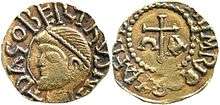 Contemporary effigy of Dagobert from a gold triens | |
| King of Neustria and Burgundy | |
| Reign | 634-639 |
| Successor | Clovis II |
| King of the Franks | |
| Reign | 629–634 |
| Predecessor | Vacant (last held by Chlothar II) |
| Successor | Vacant (next held by Theuderic III) |
| King of Austrasia | |
| Reign | 623-629 |
| Predecessor | Chlothar II |
| Successor | Sigebert III |
| Born | c. 603[1] |
| Died |
19 January 639 Épinay-sur-Seine |
| Burial | Saint Denis Basilica, Paris |
| Spouse |
Gormatrude Nanthild Wulfegundis Berchildis Ragnetrude (concubine) |
| Issue |
Sigebert III Clovis II |
| Dynasty | Merovingian |
| Father | Chlothar II |
| Mother | Haldetrude |
| Signature |
|
Dagobert I (Latin: Dagobertus; c. 603 – 19 January 639 AD) was the king of Austrasia (623–634), king of all the Franks (629–634), and king of Neustria and Burgundy (629–639). He was the last king of the Merovingian dynasty to wield any real royal power.[2] Dagobert was the first of the Frankish kings to be buried in the royal tombs at Saint Denis Basilica.[3]
Rule in Austrasia
Dagobert was the eldest son of Chlothar II and Haldetrude (575–604). Chlothar had reigned alone over all the Franks since 613. In 623, Chlothar was forced to make Dagobert king of Austrasia by the nobility of that region, who wanted a king of their own.
When Chlothar granted Austrasia to Dagobert, he initially excluded Alsace, the Vosges, and the Ardennes, but shortly thereafter the Austrasian nobility forced him to concede these regions to Dagobert. The rule of a Frank from the Austrasian heartland tied Alsace more closely to the Austrasian court. Dagobert created a new duchy (the later Duchy of Alsace) in southwest Austrasia to guard the region from Burgundian or Alemannic encroachments and ambitions. The duchy comprised the Vosges, the Burgundian Gate, and the Transjura. Dagobert made his courtier Gundoin the first duke of this new polity that was to last until the end of the Merovingian dynasty.
United rule
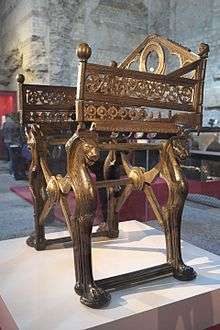
Upon the death of his father in 629, Dagobert inherited the Neustrian and Burgundian kingdoms. His half-brother Charibert, son of Sichilde, claimed Neustria but Dagobert opposed him. Brodulf, brother of Sichilde, petitioned Dagobert on behalf of his young nephew, but Dagobert assassinated him. He later gave the Aquitaine to Charibert as a "consolation prize."[4]
Charibert and his son Chilperic were assassinated in 632. Dagobert had Burgundy and Aquitaine firmly under his rule, becoming the most powerful Merovingian king in many years and the most respected ruler in the West. In 631, Dagobert led a large army against Samo, the ruler of the Slavs, but his Austrasian forces were defeated at Wogastisburg. [5]
Rule in Neustria, from Paris
Also in 632, the nobles of Austrasia revolted under the mayor of the palace, Pepin of Landen. In 634, Dagobert appeased the rebellious nobles by putting his three-year-old son, Sigebert III, on the throne, thereby ceding royal power in the easternmost of his realms, just as his father had done for him eleven years earlier.
As king, Dagobert made Paris his capital. During his reign, he built the Altes Schloss in Meersburg (in modern Germany), which today is the oldest inhabited castle in that country. Devoutly religious, Dagobert was also responsible for the construction of the Saint Denis Basilica, at the site of a Benedictine monastery in Paris. He also appointed St. Arbogast bishop of Strasbourg.[6]
Dagobert died in the abbey of Saint-Denis and was the first Frankish king to be buried in the Saint Denis Basilica, Paris.
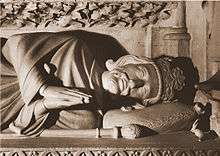
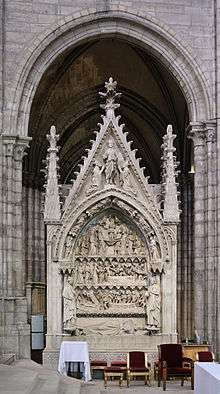
Marriage and children
The author of the Chronicle of Fredegar criticises the king for his loose morals in having "three queens almost simultaneously, as well as several concubines".[7] The chronicle names the queens, Nanthild and the otherwise obscure Wulfegundis and Berchildis, but none of the concubines, stating that a full list of concubines would be too long.
In 625/6 Dagobert married Gormatrude, a sister of his father's wife Sichilde; but the marriage was childless. After divorcing Gormatrude in 629/30 he made Nanthild, a Saxon servant (puella) from his personal entourage, his new queen.[8] She gave birth to:
- Clovis II (b. 634/5) later king of Neustria and Burgundy.
Shortly after his marriage to Nanthild, he took a girl called Ragnetrude to his bed, who gave birth to his youngest son:
- Sigebert III (b. 630/1) later king of Austrasia.
It has been speculated that Regintrud, abbess of Nonnberg Abbey, was also a child of Dagobert, although this theory does not fit Regintrud's supposed date of birth between 660 and 665. She married into the Bavarian Agilolfing family (either Theodo, Duke of Bavaria or his son Duke in Salzburg).
Coinage and treasures under Dagobert
Treasure of Dagobert
 Treasures of Dagobert - Abel Hugo - France historique et monumentale (1837).
Treasures of Dagobert - Abel Hugo - France historique et monumentale (1837).
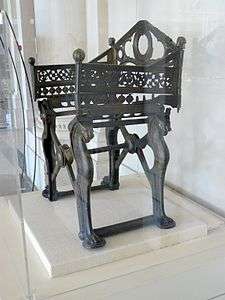 Throne of Dagobert
Throne of Dagobert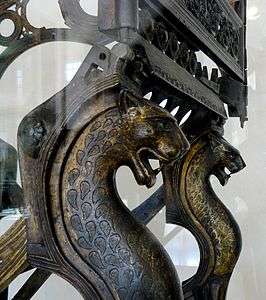 Throne of Dagobert (detail)
Throne of Dagobert (detail)
Coinage

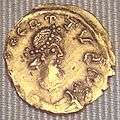
 Triens of Dagobert I and moneyer Romanos, Augaune, 629-639, gold 1.32g. Monnaie de Paris.
Triens of Dagobert I and moneyer Romanos, Augaune, 629-639, gold 1.32g. Monnaie de Paris.
Ancestry
| Ancestors of Dagobert I | |||||||||||||||||||||||||||||||||||||||||||||||||||||||||||||||||||||||||||||||||||||||||||||||||||||||||||||||||||||||||||||||||||||||||||||||||||||||||||||||||||||||||||||||||||||||||||||||||||||||||||||||||||||||||||||||||||||||||||||||||||||||||||||||||||||||||||||||||||||||||||||||||||||||||||||||||||||||||||||||||||||||||||||||||||||||||||||||||||||||||||||||||||||||||||||||||||||||||||||||||||||||||||||||||||||||||||||||||||||||||||||||||||||||||||||||||||
|---|---|---|---|---|---|---|---|---|---|---|---|---|---|---|---|---|---|---|---|---|---|---|---|---|---|---|---|---|---|---|---|---|---|---|---|---|---|---|---|---|---|---|---|---|---|---|---|---|---|---|---|---|---|---|---|---|---|---|---|---|---|---|---|---|---|---|---|---|---|---|---|---|---|---|---|---|---|---|---|---|---|---|---|---|---|---|---|---|---|---|---|---|---|---|---|---|---|---|---|---|---|---|---|---|---|---|---|---|---|---|---|---|---|---|---|---|---|---|---|---|---|---|---|---|---|---|---|---|---|---|---|---|---|---|---|---|---|---|---|---|---|---|---|---|---|---|---|---|---|---|---|---|---|---|---|---|---|---|---|---|---|---|---|---|---|---|---|---|---|---|---|---|---|---|---|---|---|---|---|---|---|---|---|---|---|---|---|---|---|---|---|---|---|---|---|---|---|---|---|---|---|---|---|---|---|---|---|---|---|---|---|---|---|---|---|---|---|---|---|---|---|---|---|---|---|---|---|---|---|---|---|---|---|---|---|---|---|---|---|---|---|---|---|---|---|---|---|---|---|---|---|---|---|---|---|---|---|---|---|---|---|---|---|---|---|---|---|---|---|---|---|---|---|---|---|---|---|---|---|---|---|---|---|---|---|---|---|---|---|---|---|---|---|---|---|---|---|---|---|---|---|---|---|---|---|---|---|---|---|---|---|---|---|---|---|---|---|---|---|---|---|---|---|---|---|---|---|---|---|---|---|---|---|---|---|---|---|---|---|---|---|---|---|---|---|---|---|---|---|---|---|---|---|---|---|---|---|---|---|---|---|---|---|---|---|---|---|---|---|---|---|---|---|---|---|---|---|---|---|---|---|---|---|---|---|---|---|---|---|---|---|---|---|---|---|---|---|---|---|---|---|---|---|---|---|---|---|---|---|---|---|---|---|---|---|---|---|---|---|---|---|---|---|---|---|---|---|---|---|---|---|---|---|---|---|---|---|---|---|---|---|---|---|---|---|---|---|---|---|---|---|---|---|---|---|---|---|---|---|---|---|---|---|---|---|---|---|
| |||||||||||||||||||||||||||||||||||||||||||||||||||||||||||||||||||||||||||||||||||||||||||||||||||||||||||||||||||||||||||||||||||||||||||||||||||||||||||||||||||||||||||||||||||||||||||||||||||||||||||||||||||||||||||||||||||||||||||||||||||||||||||||||||||||||||||||||||||||||||||||||||||||||||||||||||||||||||||||||||||||||||||||||||||||||||||||||||||||||||||||||||||||||||||||||||||||||||||||||||||||||||||||||||||||||||||||||||||||||||||||||||||||||||||||||||||
References
- ↑ Paul Oldfield, Sanctity and Pilgrimage in Medieval Southern Italy, 1000-1200, (Cambridge University Press, 2014), 218.
- ↑ Rose Williams, The Lighter Side of The Dark Ages, page 52 (Anthem Press, 2005). ISBN 1-84331-192-5
- ↑ Georges Duby, France in the Middle Ages 987-1460: from Hugh Capet to Joan of Arc, page 134 (Blackwell Publishers, 1991) ISBN 0-631-18945-9
- ↑ Deutsch, Lorànt (2013). Metronome: A History of Paris from the Underground Up. New York: St. Martin's. p. 96. Retrieved 29 December 2017.
- ↑ Jaques, Tony (2011). Dictionary of Battles and Sieges: P-Z, Vol. 3. Westport: Greenwood. p. 1109. Retrieved 29 December 2017.
- ↑ Arbogast of Strasbourg, Oxford Dictionary of Saints, 5th Edition, Ed.David Hugh Farmer, (Oxford University Press, 2004), 32.
- ↑ Fredegar IV, 60.
- ↑ Fredegar IV, 58: Nantechildem unam ex puellis de menisterio matrimonium accipiens reginam sublimavit.
External links
| Wikimedia Commons has media related to Dagobert I. |
| Wikisource has the text of the 1911 Encyclopædia Britannica article Dagobert I. |
Dagobert I Born: 605 Died: 19 January 639 | ||
| Preceded by Chlothar II |
King of Austrasia 623–629 |
Succeeded by Sigebert III |
| Preceded by Chlothar II |
King of the Franks 629–634 |
Vacant Title next held by Theuderic III |
| New title Gaul partitioned |
King of Neustria and Burgundy 634–639 |
Succeeded by Clovis II |
